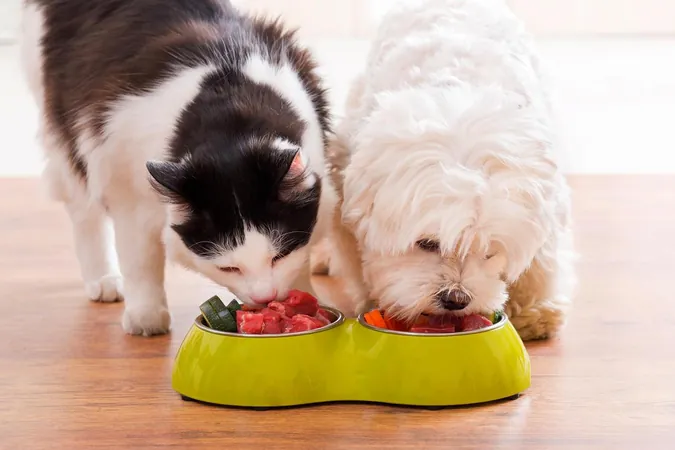
The Shocking Truth About Raw Food Diets for Pets – What You Need to Know!
2025-01-19
Author: Wei Ling
In recent years, the trend of feeding pets like dogs and cats a raw food diet has surged in popularity, with proponents claiming it leads to better digestion, glossier fur, and healthier teeth. However, the notion of a raw diet may come with unexpected dangers that every pet owner should consider.
Veterinary experts are wary of these raw diets, as there is a significant lack of quality data and scientific support to validate the supposed benefits. In fact, emerging evidence suggests that the risks associated with feeding pets raw food heavily outweigh any claimed advantages, posing serious health threats to both pets and their human families.
What Is a Raw Food Diet for Pets?
A raw food diet generally includes uncooked meats, bones, organ meats, and raw fruits and vegetables—intended to replicate the diets of wild ancestors. However, this approach fails to account for the significant evolutionary changes and health requirements that pets have today, vastly different from their wild counterparts, making this diet a questionable choice.
Identifying the Health Risks of Raw Diets
1. Pathogenic Contamination.
The consumption of raw pet food increases the risk of exposure to harmful bacteria such as Salmonella and Escherichia coli. These pathogens can lead to severe illness in pets, resulting in symptoms like vomiting and diarrhea, or even potentially severe systemic infections. Moreover, pets shedding these disease-causing bacteria pose risks to humans, especially children, elderly individuals, and those with weakened immune systems. Freezing or freeze-drying raw food does not guarantee the elimination of all harmful pathogens.
2. HPAI Threats.
Recent recalls of raw poultry pet food products associated with highly pathogenic avian influenza (HPAI) have raised serious red flags. Pets consuming raw tissues from infected birds are at risk of contracting the virus, which not only affects their health but raises alarms regarding zoonotic transmission—a situation in which diseases can jump from animals to humans.
3. Nutritional Imbalances.
One of the most significant concerns with raw diets is their potential nutritional inadequacy. Preparing a well-balanced raw diet is incredibly challenging, and many pet owners may unknowingly create deficiencies or surpluses of critical nutrients, potentially leading to serious health issues in growing or senior pets. Unlike commercial pet foods, which are crafted to meet strict dietary guidelines, homemade raw diets often lack consistency and quality control.
The Bigger Picture: Impacts on Public and Animal Health
The repercussions of feeding pets raw diets extend beyond individual homes and can contribute to larger public health issues. The carryover of pathogens between pets and humans may lead to outbreaks of infections, increasing the strain on public health resources. Furthermore, raw diets are often associated with the spread of antimicrobial-resistant bacteria; these resistant strains can circulate even in healthy pets, presenting dire consequences for wider community health.
The sobering HPAI pet food recalls serve as a cautionary tale about the vulnerabilities tied to raw feeding. These incidents underscore the importance of prioritizing scientifically-backed nutrition. Pet owners should consult with qualified veterinary professionals to ensure they are making informed and safe dietary choices for their furry companions.
In summary, while the idea of mirroring a pet’s ancestral diet may sound appealing, today’s pets live in an entirely different environment with distinct health requirements. Responsible pet care demands not just attention to nutrition but also a commitment to health and safety, for pets and their humans alike.
— Stay informed, stay safe, and give your pets the healthiest lives possible by choosing evidence-based nutrition!


 Brasil (PT)
Brasil (PT)
 Canada (EN)
Canada (EN)
 Chile (ES)
Chile (ES)
 Česko (CS)
Česko (CS)
 대한민국 (KO)
대한민국 (KO)
 España (ES)
España (ES)
 France (FR)
France (FR)
 Hong Kong (EN)
Hong Kong (EN)
 Italia (IT)
Italia (IT)
 日本 (JA)
日本 (JA)
 Magyarország (HU)
Magyarország (HU)
 Norge (NO)
Norge (NO)
 Polska (PL)
Polska (PL)
 Schweiz (DE)
Schweiz (DE)
 Singapore (EN)
Singapore (EN)
 Sverige (SV)
Sverige (SV)
 Suomi (FI)
Suomi (FI)
 Türkiye (TR)
Türkiye (TR)
 الإمارات العربية المتحدة (AR)
الإمارات العربية المتحدة (AR)